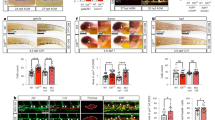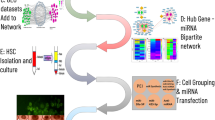Abstract
Previous studies on developmental hematopoiesis have mainly focused on signaling and transcription factors, while the appreciation of epigenetic regulation including that of microRNAs is recent. Here, we show that in zebrafish and mouse, miR-142-3p is specifically expressed in hematopoietic stem cells (HSCs). Knockdown of miR-142a-3p in zebrafish led to a reduced population of HSCs in the aorta-gonad-mesonephros (AGM) region as well as T-cell defects in the thymus. Mechanistically, miR-142a-3p regulates HSC formation and differentiation through the repression of interferon regulatory factor 7 (irf7)-mediated inflammation signaling. Finally, we show that miR-142-3p is also involved in the development of HSCs in mouse AGM, suggesting that it has a highly conserved role in vertebrates. Together, these findings unveil the pivotal roles that miR-142a-3p plays in the formation and differentiation of HSCs by repressing irf7 signaling.
Similar content being viewed by others
Log in or create a free account to read this content
Gain free access to this article, as well as selected content from this journal and more on nature.com
or
References
Zhang C, Patient R, Liu F . Hematopoietic stem cell development and regulatory signaling in zebrafish. Biochim Biophys Acta 2013; 1830:2370–2374.
Orkin SH, Zon LI . Hematopoiesis: an evolving paradigm for stem cell biology. Cell 2008; 132:631–644.
Kissa K, Herbomel P . Blood stem cells emerge from aortic endothelium by a novel type of cell transition. Nature 2010; 464:112–115.
Bertrand JY, Chi NC, Santoso B, et al. Haematopoietic stem cells derive directly from aortic endothelium during development. Nature 2010; 464:108–111.
Bartel DP . MicroRNAs: genomics, biogenesis, mechanism, and function. Cell 2004; 116:281–297.
Forman JJ, Coller HA . The code within the code: microRNAs target coding regions. Cell Cycle 2010; 9:1533–1541.
O'Connell RM, Baltimore D . MicroRNAs and hematopoietic cell development. Curr Top Dev Biol 2012; 99:145–174.
Bissels U, Bosio A, Wagner W . MicroRNAs are shaping the hematopoietic landscape. Haematologica 2012; 97:160–167.
Lechman ER, Gentner B, van Galen P, et al. Attenuation of miR-126 activity expands HSC in vivo without exhaustion. Cell Stem Cell 2012; 11:799–811.
Grabher C, Payne EM, Johnston AB, et al. Zebrafish microRNA-126 determines hematopoietic cell fate through c-Myb. Leukemia 2011; 25:506–514.
Dore LC, Amigo JD, Dos Santos CO, et al. A GATA-1-regulated microRNA locus essential for erythropoiesis. Proc Natl Acad Sci USA 2008; 105:3333–3338.
Fu YF, Du TT, Dong M, et al. Mir-144 selectively regulates embryonic alpha-hemoglobin synthesis during primitive erythropoiesis. Blood 2009; 113:1340–1349.
Pase L, Layton JE, Kloosterman WP, et al. miR-451 regulates zebrafish erythroid maturation in vivo via its target gata2. Blood 2009; 113:1794–1804.
Ramkissoon SH, Mainwaring LA, Ogasawara Y, et al. Hematopoietic-specific microRNA expression in human cells. Leuk Res 2006; 30:643–647.
Chen CZ, Li L, Lodish HF, Bartel DP . MicroRNAs modulate hematopoietic lineage differentiation. Science 2004; 303:83–86.
Reddy AM, Zheng Y, Jagadeeswaran G, et al. Cloning, characterization and expression analysis of porcine microRNAs. BMC Genomics 2009; 10:65.
Liao R, Sun J, Zhang L, et al. MicroRNAs play a role in the development of human hematopoietic stem cells. J Cell Biochem 2008; 104:805–817.
Jin P, Wang E, Ren J, et al. Differentiation of two types of mobilized peripheral blood stem cells by microRNA and cDNA expression analysis. J Transl Med 2008; 6:39.
Sun W, Shen W, Yang S, et al. miR-223 and miR-142 attenuate hematopoietic cell proliferation, and miR-223 positively regulates miR-142 through LMO2 isoforms and CEBP-beta. Cell Res 2010; 20:1158–1169.
Bissels U, Wild S, Tomiuk S, et al. Combined characterization of microRNA and mRNA profiles delineates early differentiation pathways of CD133+ and CD34+ hematopoietic stem and progenitor cells. Stem Cells 2011; 29:847–857.
Yuan W, Sun W, Yang S, et al. Downregulation of microRNA-142 by proto-oncogene LMO2 and its co-factors. Leukemia 2008; 22:1067–1071.
Wang XS, Gong JN, Yu J, et al. MicroRNA-29a and microRNA-142-3p are regulators of myeloid differentiation and acute myeloid leukemia. Blood 2012; 119:4992–5004.
Sun Y, Varambally S, Maher CA, et al. Targeting of microRNA-142-3p in dendritic cells regulates endotoxin-induced mortality. Blood 2011; 117:6172–6183.
Nishiyama T, Kaneda R, Ono T, et al. miR-142-3p is essential for hematopoiesis and affects cardiac cell fate in zebrafish. Biochem Biophys Res Commun 2012; 425:755–761.
Lalwani MK, Sharma M, Singh AR, et al. Reverse genetics screen in zebrafish identifies a role of miR-142a-3p in vascular development and integrity. PLoS One 2012; 7:e 52588.
North TE, Goessling W, Walkley CR, et al. Prostaglandin E2 regulates vertebrate haematopoietic stem cell homeostasis. Nature 2007; 447:1007–1011.
Ozato K, Tailor P, Kubota T . The interferon regulatory factor family in host defense: mechanism of action. J Biol Chem 2007; 282:20065–20069.
Balaraman S, Tewary P, Singh VK, Madhubala R . Leishmania donovani induces interferon regulatory factor in murine macrophages: a host defense response. Biochem Biophys Res Commun 2004; 317:639–647.
Fredericksen BL, Gale M Jr . West Nile virus evades activation of interferon regulatory factor 3 through RIG-I-dependent and -independent pathways without antagonizing host defense signaling. J Virol 2006; 80:2913–2923.
Tamura T, Ozato K . ICSBP/IRF-8: its regulatory roles in the development of myeloid cells. J Interferon Cytokine Res 2002; 22:145–152.
Hall CJ, Flores MV, Oehlers SH, et al. Infection-responsive expansion of the hematopoietic stem and progenitor cell compartment in zebrafish is dependent upon inducible nitric oxide. Cell Stem Cell 2012; 10:198–209.
Liongue C, Hall CJ, O'Connell BA, Crosier P, Ward AC . Zebrafish granulocyte colony-stimulating factor receptor signaling promotes myelopoiesis and myeloid cell migration. Blood 2009; 113:2535–2546.
North TE, Goessling W, Peeters M, et al. Hematopoietic stem cell development is dependent on blood flow. Cell 2009; 137:736–748.
Wang L, Zhang P, Wei Y, et al. A blood flow-dependent klf2a-NO signaling cascade is required for stabilization of hematopoietic stem cell programming in zebrafish embryos. Blood 2011; 118:4102–4110.
Li Z, Lan Y, He W, et al. Mouse embryonic head as a site for hematopoietic stem cell development. Cell Stem Cell 2012; 11:663–675.
Mildner A, Chapnik E, Manor O, et al. Mononuclear phagocyte miRNome analysis identifies miR-142 as critical regulator of murine dendritic cell homeostasis. Blood 2013; 121:1016–1027.
Nimmo R, Ciau-Uitz A, Ruiz-Herguido C, et al. miR-142-3p controls the specification of definitive hemangioblasts during ontogeny. Dev Cell 2013; 26:237–249.
Takizawa H, Boettcher S, Manz MG . Demand-adapted regulation of early hematopoiesis in infection and inflammation. Blood 2012; 119:2991–3002.
Li L, Jin H, Xu J, et al. Irf8 regulates macrophage versus neutrophil fate during zebrafish primitive myelopoiesis. Blood 2011; 117:1359–1369.
Wang H, Lee CH, Qi C, et al. IRF8 regulates B-cell lineage specification, commitment, and differentiation. Blood 2008; 112:4028–4038.
Kimmel CB, Ballard WW, Kimmel SR, Ullmann B, Schilling TF . Stages of embryonic development of the zebrafish. Dev Dyn 1995; 203:253–310.
Lawson ND, Weinstein BM . In vivo imaging of embryonic vascular development using transgenic zebrafish. Dev Biol 2002; 248:307–318.
Stainier DY, Weinstein BM, Detrich HW III, et al. Cloche, an early acting zebrafish gene, is required by both the endothelial and hematopoietic lineages. Development 1995; 121:3141–3150.
Covassin L, Amigo JD, Suzuki K, et al. Global analysis of hematopoietic and vascular endothelial gene expression by tissue specific microarray profiling in zebrafish. Dev Biol 2006; 299:551–562.
Acknowledgements
We thank the laboratory members for helpful discussions and critical reading of the paper. This work was supported by the National Basic Research Program of China (2010CB945300, 2011CB943900, and 2012CB945101), the National Natural Science Foundation of China (31271570, 90919055), and the Strategic Priority Research Program of the Chinese Academy of Sciences (XDA01010110).
Author information
Authors and Affiliations
Corresponding author
Additional information
( Supplementary information is linked to the online version of the paper on the Cell Research website.)
Supplementary information
Supplementary information, Figure S1
Conservation of miR-142-3p sequence in vertebrates and its expression during embryogenesis. (PDF 147 kb)
Supplementary information, Figure S2
Unaltered expression of selected developmental markers and decreased expression of miR-142-3p in embryos injected with 3p MO1 or MO2. (PDF 149 kb)
Supplementary information, Figure S3
miR-142a-3p MO-2 injected embryos displays similar HSC and T cell defects compared to miR-142-3p MO1 injected embryos. (PDF 359 kb)
Supplementary information, Figure S4
Validation of candidate downstream targets of miR-142a-3p. (PDF 383 kb)
Supplementary information, Table S1
The MOs designed and used in this work. (PDF 457 kb)
Supplementary information, Table S2
The PCR primers used in qPCR assay and the sequences of mmu-miR-142-3p inhibitor and duplex. (PDF 728 kb)
Rights and permissions
About this article
Cite this article
Lu, X., Li, X., He, Q. et al. miR-142-3p regulates the formation and differentiation of hematopoietic stem cells in vertebrates. Cell Res 23, 1356–1368 (2013). https://doi.org/10.1038/cr.2013.145
Received:
Revised:
Accepted:
Published:
Issue date:
DOI: https://doi.org/10.1038/cr.2013.145
Keywords
This article is cited by
-
Acquired miR-142 deficit in leukemic stem cells suffices to drive chronic myeloid leukemia into blast crisis
Nature Communications (2023)
-
Learning noncoding RNA biology from viruses
Mammalian Genome (2022)
-
Non-coding RNAs regulation of macrophage polarization in cancer
Molecular Cancer (2021)
-
Serum miRNA as a possible biomarker in the diagnosis of bipolar II disorder
Scientific Reports (2020)
-
Neutrophil extracellular trap-enriched supernatants carry microRNAs able to modulate TNF-α production by macrophages
Scientific Reports (2020)



